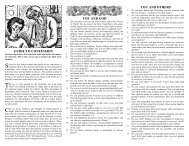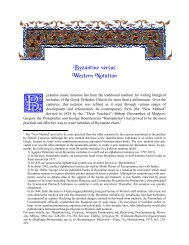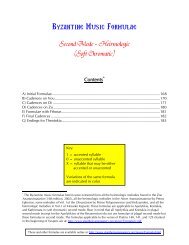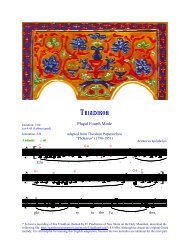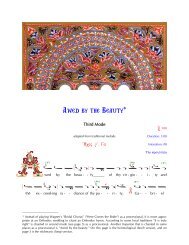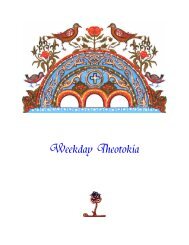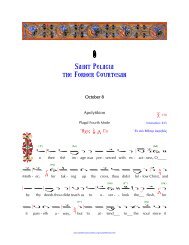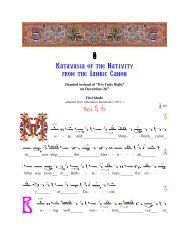Reading Psalmodia (PDF) - St. Anthony's Monastery
Reading Psalmodia (PDF) - St. Anthony's Monastery
Reading Psalmodia (PDF) - St. Anthony's Monastery
Create successful ePaper yourself
Turn your PDF publications into a flip-book with our unique Google optimized e-Paper software.
Here each of the steps of the scale contains precisely the same number of steplets thatthe corresponding interval between the notes of the scale as it is played on the pianowould contain. The sequence Di Ke Zo Ni', that is to say, is produced by singing asequence of notes starting from Di such that the successive notes are respectively 12, 6and 12 steplets above the note preceding. Playing the successive notes G A B b C on thepiano produces an identical sequence of notes starting on G and rising by 12, 6and 12 steplets successively.The natural Diatonic scale is different. It contains three different sizes of interval, nottwo. Here is the interpretation of the diatonic scale on F (Ga) generally accepted bymodern psaltic theorists.F G A B b C D E F| 12 | 10 | 8 | 12 | 12 | 10 | 8 |Ga Di Ke Zo Ni Pa Vu Ga'Here we have large tones of 12 steplets, identical in size with the Enharmonic tones, butaccompanied by lesser tones of 10 steplets and large semitones of 8 steplets. It isimportant, however, to remember this is a theoretical analysis of the difference betweenthe Diatonic and the Enharmonic types of scale: in practise the intervals singers actuallysing may not correspond exactly to either pattern: some singers make less distinctionamongst the diatonic intervals than the analysis would suggest, some actually make nodistinction between the sung versions of the Diatonic and the Enharmonic type.The Hard Chromatic Scale is most familiar in <strong>Psalmodia</strong> as the scale of a mode used inboth the Second Tone and the Second Plagal Tone which has Pa (D) as its basic note.D E b F# G A B b C# D| 6 | 20 | 4 | 12 | 6 | 20 | 4 |Pa Vu Ga Di Ke Zo Ni' Pa'The Soft Chromatic Scale is used mainly in the principal mode of the Second Tone, butalso provides the scale of an important mode in Tone Four and the second principalmode of Tone Plagal Two.C D b E F G A b B C| 8 | 14 | 8 | 12 | 8 | 14 | 8 |Ni Pa Vu Ga Di Ke Zo Ni'This scale is much easier to sing than might at first sight appear. One thing, however,should be noted: the flat A/Ke of the Soft Chromatic scale is a large (diatonic) semitoneabove G/Di , it is definitely not an enharmonic semitone above. It is acceptable to singthe Di less than 14 steplets flatter than B; it is not acceptable to sing it more than 14steplets flatter than B. Attempting to play melodies in this mode on the piano produces7





